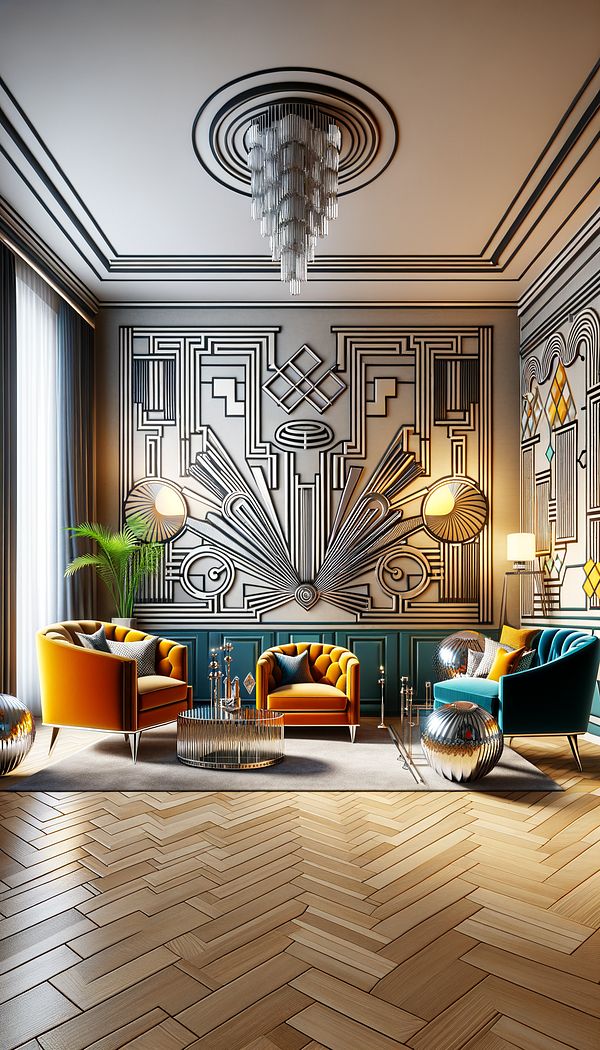What is Deco?
Deco, short for Art Deco, is a visual arts design style that emerged in the 1920s and 1930s.
Description
Deco, which stands for Art Deco, represents a distinctive style known for its bold geometric shapes, rich colors, and lavish ornamentation. Originating in the 1920s and extending into the 1930s, this design movement was a response to the desire for modernity and embraced technological progress, which was reflected in its use of new materials such as chrome, stainless steel, and inlaid wood. Deco's influence was not limited to interior design; it also made significant marks in architecture, fashion, and even industrial design.
The style is synonymous with luxury and opulence, often featuring symmetrical designs, zigzag patterns, and stylized floral and sunrise motifs. The aim was to create a sleek, streamlined aesthetic that symbolized wealth and sophistication. In interior design, Art Deco is celebrated for its daring use of contrast, intricate details, and emphasis on craftsmanship.
Despite its specific historical period, Deco has experienced various revivals and continues to inspire contemporary interior design. Today, integrating Deco elements into modern spaces can add a sense of glamour and timeless elegance. It's particularly appealing for those looking to create a space that blends historical richness with modernity.
Usage
In the context of interior design, Deco can be applied through the use of geometric-patterned wallpapers, bold and angular furniture pieces, luxurious fabrics like silk and velvet, and decorative objects made of chrome and glass. It's commonly seen in the design of lobbies, theaters, and homes that aim to capture the essence of the 1920s and 1930s' glamour and sophistication. Incorporating Deco elements can transform a space, giving it a unique blend of historical richness and contemporary style.
FAQs
-
Is Art Deco the same as Deco?
Yes, Deco is short for Art Deco, referring to the same design style that emerged in the 1920s and 1930s.
-
Can Deco be incorporated into modern interior design?
Absolutely. Deco elements can be integrated into modern spaces to add glamour and a sense of timeless elegance, blending historical richness with contemporary style.
-
What materials are typically associated with Deco design?
Deco design often features materials such as chrome, stainless steel, inlaid wood, silk, and velvet, reflecting its emphasis on luxury and modernity.
-
What are common motifs found in Deco design?
Common motifs include symmetrical designs, zigzag patterns, stylized floral and sunrise motifs, emphasizing the style's love for boldness and ornamentation.
Practical Application
When incorporating Deco elements into your space, focus on combining bold geometric shapes with luxurious materials and rich colors. Use strategic lighting to highlight the lavish details and consider incorporating chrome or glass decorative objects for that signature Deco opulence. Opting for wallpapers with geometric or stylized patterns can also enhance the Deco aesthetic in your interior design.
-
Design Styles478 articles
-
Furniture Types599 articles
-
Decorative Objects240 articles
-
Materials & Textiles360 articles
-
Wall Treatments & Finishes157 articles
-
Persian RugA Persian rug is a handwoven carpet from Iran, known for its intricate designs and high quality.
-
AbacusAn abacus is a flat slab forming the top of a column capital.
-
Radiator CoverA radiator cover is a protective decorative casing placed around a radiator.
-
SheratonSheraton refers to a classic British furniture style that emerged in the late 18th century.
-
Block FootBlock Foot is a type of foot design used in furniture.
